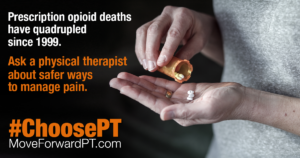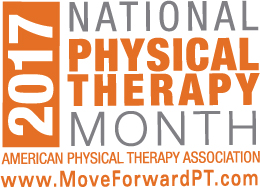
Did you know that October is National Physical Therapy Month? The month of October is a period during which the American Physical Therapy Association, along with healthcare organizations and individual therapists across the country, makes a focused effort to highlight the physical therapy profession’s efforts to “transform the human experience by optimizing movement.” Each year, a theme is chosen for the month that reflects an aspect of how physical therapists utilize movement to improve the health, mobility, and quality of life for their clients. In 2017, the APTA has chosen to carry forward the theme of last year’s Physical Therapy Month, which is to raise awareness about how physical therapy is a safe and effective alternative to opioid medications for the long-term treatment and management of chronic pain.
Last October, in conjunction with National Physical Therapy Month, Symmetry published this blog – detailing some of the staggering statistics associated with the opioid epidemic being experienced across the United States. (For another brief tutorial about the effects of opioid use, check out this YouTube video posted by MoveForwardPT.) Currently, despite the fact that news of the ongoing significant negative impact that opioid addiction wreaks on our health and in our communities, Americans continue to be prescribed opioid pain medications at alarming rates. According to this annual report published by the Centers for Disease Control and Prevention, in 2016 prescribers wrote on average 66.5 opioid and 25.2 sedative prescriptions for every 100 Americans. Rates of prescription vary state by state. Texans specifically were dispensed 72-82 opioid prescriptions for every 100 citizens! (This number – alarming by itself – becomes even more outrageous when considering that about 34% of the Texas population is under the age of 18. That leaves more than 1 opioid prescription for every single adult in the state.)
This year, Symmetry Physical Therapy would like to put forth a consideration of one of the other significant effects that high levels of opioid use have on our society. Recently, an article was published in one of the major US news magazines that presented an extremely eye opening view of the cascade of prescription medication use that has come along with America’s collective use of opioid pain medications. Here are a few of the statistics presented in this article:
- – 33,000 Americans died in 2015 from opioid overdose
- – It costs $4,100 to purchase an auto-injector that can reverse the effects of an opioid overdose.
- – In 2016, pharmaceutical companies reported $8.6 billion in sales of opioid prescriptions
- – Prescription sales for medications that treat the side effects of opioids total approximately $3 billion each year. This number is expected to grow to > $6 billion by 2022.
In 2015, the U.S. is estimated to have spent $4.4 billion on substance-abuse treatment. This number is projected to be $12.4 billion by 2024.
There are several common side-effects to taking opioid pain medication. One of the most familiar is constipation – resulting from the pain medication’s numbing effects on the receptors in the intestines that are meant to keep things moving. Movantix and Relistor are two of the medications that are often prescribed to address this issue. Nausea is another common side-effect. Benadryl, Meclizine or Duragesic (fentanyl) patches might be prescribed to treat this effect. Depression is a third fairly common experience associated long-term opiate use. Zoloft or Norpramin are different types of medications that might be utilized in these cases. Each of these adjunctive medications also has its own set of potential side-effects, which may ultimately result in a further cascade of prescription medication use.
Beyond treating side-effects – providing treatment of opioid addiction and overdose also drives utilization of additional medication. Physicians are being encouraged to prescribe additional drugs to combat addiction and overdose at the same time as opioid pain medications, just in case these issues occur. Naltrexone and Naloxone are common prescriptions for the treatment of opioid addiction. Narcan and Evzio are drugs used for overdose-reversal. It’s not only patients with pain that are utilizing prescriptions for addiction and overdose antidotes. Police departments and emergency medical service (EMS) providers across the country are also stocking up on this sort of medication so that they can be provided during response to incidents in the community that involve opioids.
The expense to both private citizens and public health organizations for both opioids and other drugs associated with the treatment of opioid use is clearly significant. This issue presents an ethical puzzle that will undoubtedly be an issue for a prolonged period. Drug manufacturers are incentivized to raise prices on their products in response to increased demand. Cities, hospitals, and a variety of medical care providers are compelled to ensure access to medications known to be valuable for the maintenance of public health. Individual citizens need and deserve adequate instruction in the relative benefits and risks of the application of pain medication in any specific circumstance. None of this will be simple.
The promotion of alternative, non-pharmaceutical means by which to manage pain should be a common goal as we work as a community to address the difficult issues of opioid use and misuse. To this goal, Symmetry and the American Physical Therapy Association invite the consideration of choosing to try physical therapy treatment as an alternative to pharmaceutical pain medication. It is well-documented that restoring and optimizing movement – the cornerstone of physical therapy treatment – has a multitude of both curative and preventative effects on human health. People that move better feel better. They have less pain. They stay more active. They function better. They live longer. Side effects of physical therapy include things like better posture, increased strength, improved endurance, and longer-term successful participation in daily activities – from housework to horse-back riding. And besides these effects, a benefit of physical therapy treatment is that it costs a fraction of the expense of long-term use of prescription medication.
Please celebrate National Physical Therapy Month with us. Help us to relay the message to the greater general public that physical therapy is a safe, effective choice for the treatment of pain. Help your community to understand that they have a choice in the manner in which they treat pain symptoms. Encourage the asking of questions and the seeking of alternatives to opioid pain medication. We’ll all be healthier for it!

